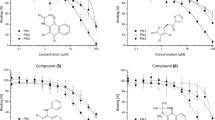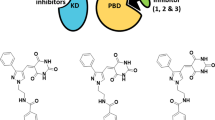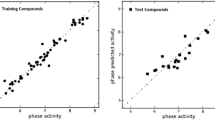Abstract
Polo-like kinase 1 (Plk1), a member of a family of serine/threonine kinases, is an attractive target for the development of anticancer drugs because it is involved in the regulation of cell-cycle progression and cytokinesis. This kinase provides two pockets for developing Plk1 inhibitors: the N-terminal catalytic domain (NCD) and the polo-box domain (PBD). For both of the two pockets, some natural products were identified as Plk1 inhibitors and some synthetic Plk1 inhibitors were developed by mimicking ATP and phosphopeptides, natural products binding to NCD and PBD respectively. This article not only reviews the progression of Plk1 inhibitors binding to these two pockets, but also discusses diversity evolution and jump in the process of drug development using Plk1 inhibitors as examples and how they impact on drug design and pharmacophore modeling.
Similar content being viewed by others
References
Gorse AD. Diversity in medicinal chemistry space. Curr Top Med Chem, 2006, 6: 3–18
Xu J, Gu Q, Liu HB, Zhou JJ, Bu XZ, Huang ZS, Lu G, Li D, Wei DQ, Wang L, Gu LQ. Chemomics and drug innovation. Sci China Chem, 2013, 56: 71–85
Lachance H, Wetzel S, Kumar K, Wadmann H. Charting, navigating, and populating natural product chemical space for drug discovery. J Med Chem, 2012, 55: 5989–6001
Newman DJ, Cragg GM. Natural product scaffolds as leads to drugs. Future Med Chem, 2009, 1: 1415–1427
Liao C, Sitzmann M, Pugliese A, Nicklaus MC. Software and resources for computational medicinal chemistry. Future Med Chem, 2011, 3: 1057–1085
Cohen P. Protein kinases—the major drug targets of the twenty-first century? Nat Rev Drug Discov, 2002, 1: 309–315
Liao JJ. Molecular recognition of protein kinase binding pockets for design of potent and selective kinase inhibitors. J Med Chem, 2007, 50: 409–424
Ghose AK, Herbertz T, Pippin DA, Salvino JM, Mallamo JP. Knowledge based prediction of ligand binding modes and rational inhibitor design for kinase drug discovery. J Med Chem, 2008, 51: 5149–5171
de Carcer G, Manning G, Malumbres M. From Plk1 to Plk5: functional evolution of polo-like kinases. Cell Cycle, 2011, 10: 2255–2262
Archambault V, Glover DM. Polo-like kinases: Conservation and divergence in their functions and regulation. Nat Rev Mol Cell Biol, 2009, 10: 265–275
Knecht R, Oberhauser C, Strebhardt K. PLK (polo-like kinase), a new prognostic marker for oropharyngeal carcinomas. Int J Cancer, 2000, 89: 535–536
Schoffski P. Polo-like kinase (PLK) inhibitors in preclinical and early clinical development in oncology. Oncologist, 2009, 14: 559–570
McInnes C, Wyatt MD. PLK1 as an oncology target: current status and future potential. Drug Discovery Today, 2011, 16: 619–625
Chopra P, Sethi G, Dastidar SG, Ray A. Polo-like kinase inhibitors: an emerging opportunity for cancer therapeutics. Expert Opin Investig Drugs, 2010, 19: 27–43
Strebhardt K, Ullrich A. Targeting polo-like kinase 1 for cancer therapy. Nat Rev Cancer, 2006, 6: 321–330
Park JE, Soung NK, Johmura Y, Kang YH, Liao C, Lee KH, Park CH, Nicklaus MC, Lee KS. Polo-box domain: A versatile mediator of polo-like kinase function. Cell Mol Life Sci, 2010, 67: 1957–1970
Steegmaier M, Hoffmann M, Baum A, Lenart P, Petronczki M, Krssak M, Gurtler U, Garin-Chesa P, Lieb S, Quant J, Grauert M, Adolf GR, Kraut N, Peters JM, Rettig WJ. BI 2536, a potent and selective inhibitor of polo-like kinase 1, inhibits tumor growth in vivo. Curr Biol, 2007, 17: 316–322
Kothe M, Kohls D, Low S, Coli R, Cheng AC, Jacques SL, Johnson TL, Lewis C, Loh C, Nonomiya J, Sheils AL, Verdries KA, Wynn TA, Kuhn C, Ding YH. Structure of the catalytic domain of human polo-like kinase 1. Biochemistry, 2007, 46: 5960–5971
Rudolph D, Steegmaier M, Hoffmann M, Grauert M, Baum A, Quant J, Haslinger C, Garin-Chesa P, Adolf GR. BI 6727, a Polo-like kinase inhibitor with improved pharmacokinetic profile and broad antitumor activity. Clin Cancer Res, 2009, 15: 3094–3102
Olmos D, Barker D, Sharma R, Brunetto AT, Yap TA, Taegtmeyer AB, Barriuso J, Medani H, Degenhardt YY, Allred AJ, Smith DA, Murray SC, Lampkin TA, Dar MM, Wilson R, de Bono JS, Blagden SP. Phase I study of GSK461364, a specific and competitive Polo-like kinase 1 inhibitor, in patients with advanced solid malignancies. Clin Cancer Res, 2011, 17: 3420–3430
Spaniol K, Boos J, Lanvers-Kaminsky C. An in-vitro evaluation of the polo-like kinase inhibitor GW843682X against paediatric malignancies. Anticancer Drugs, 2011, 22: 531–542
Lansing TJ, McConnell RT, Duckett DR, Spehar GM, Knick VB, Hassler DF, Noro N, Furuta M, Emmitte KA, Gilmer TM, Mook RA, Cheung M. In vitro biological activity of a novel small-molecule inhibitor of polo-like kinase 1. Molecular Cancer Therapeutics, 2007, 6: 450–459
Beria I, Bossi RT, Brasca MG, Caruso M, Ceccarelli W, Fachin G, Fasolini M, Forte B, Fiorentini F, Pesenti E, Pezzetta D, Posteri H, Scolaro A, Re Depaolini S, Valsasina B. NMS-P937, a 4,5-dihydro-1H-pyrazolo[4,3-h]quinazoline derivative as potent and selective Polo-like kinase 1 inhibitor. Bioorg Med Chem Lett, 2011, 21: 2969–2974
Casolaro A, Golay J, Albanese C, Ceruti R, Patton V, Cribioli S, Pezzoni A, Losa M, Texido G, Giussani U, Marchesi F, Amboldi N, Valsasina B, Bungaro S, Cazzaniga G, Rambaldi A, Introna M, Pesenti E, Alzani R. The Polo-Like Kinase 1 (PLK1) Inhibitor NMS-P937 Is Effective in a New Model of Disseminated Primary CD56(+) Acute Monoblastic Leukaemia. PLoS One, 2013, 8: e58424
Caruso M, Valsasina B, Ballinari D, Bertrand J, Brasca MG, Caldarelli M, Cappella P, Fiorentini F, Gianellini LM, Scolaro A, Beria I. 5-(2-amino-pyrimidin-4-yl)-1H-pyrrole and 2-(2-amino-pyrimidin-4-yl)-1,5,6,7-tetrahydro-pyrrolo[3,2-c]pyridin-4-one derivatives as new classes of selective and orally available Polo-like kinase 1 inhibitors. Bioorg Med Chem Lett, 2012, 22: 96–101
Kwok Leung Cheung A, Ip JC, Lung HL, Zhen Wu J, Tsao SW, Li Lung M. Polo-like kinase (PLK) inhibitor, Ro5203280, has potent anti-tumor activity in nasopharyngeal carcinoma. Mol Cancer Ther, 2013
Nie Z, Feher V, Natala S, McBride C, Kiryanov A, Jones B, Lam B, Liu Y, Kaldor S, Stafford J, Hikami K, Uchiyama N, Kawamoto T, Hikichi Y, Matsumoto S, Amano N, Zhang L, Hosfield D, Skene R, Zou H, Cao X, Ichikawa T. Discovery of TAK-960: An orally available small molecule inhibitor of polo-like kinase 1 (PLK1). Bioorg Med Chem Lett, 2013, 23: 3662–3666
Hikichi Y, Honda K, Hikami K, Miyashita H, Kaieda I, Murai S, Uchiyama N, Hasegawa M, Kawamoto T, Sato T, Ichikawa T, Cao S, Nie Z, Zhang L, Yang J, Kuida K, Kupperman E. TAK-960, a novel, orally available, selective inhibitor of polo-like kinase 1, shows broad-spectrum preclinical antitumor activity in multiple dosing regimens. Mol Cancer Ther, 2012, 11: 700–709
Elling RA, Fucini RV, Romanowski MJ. Structures of the wild-type and activated catalytic domains of Brachydanio rerio Polo-like kinase 1 (Plk1): changes in the active-site conformation and interactions with ligands. Acta Crystallogr D Biol Crystallogr, 2008, 64: 909–918
Kothe M, Kohls D, Low S, Coli R, Rennie GR, Feru F, Kuhn C, Ding YH. Selectivity-determining residues in Plk1. Chem Biol Drug Des, 2007, 70: 540–546
Toyoshima-Morimoto F, Taniguchi E, Shinya N, Iwamatsu A, Nishida E. Polo-like kinase 1 phosphorylates cyclin B1 and targets it to the nucleus during prophase. Nature, 2001, 410: 215–220
Duffey MO, Vos TJ, Adams R, Alley J, Anthony J, Barrett C, Bharathan I, Bowman D, Bump NJ, Chau R, Cullis C, Driscoll DL, Elder A, Forsyth N, Frazer J, Guo J, Guo L, Hyer ML, Janowick D, Kulkarni B, Lai SJ, Lasky K, Li G, Li J, Liao D, Little J, Peng B, Qian MG, Reynolds DJ, Rezaei M, Scott MP, Sells TB, Shinde V, Shi QJ, Sintchak MD, Soucy F, Sprott KT, Stroud SG, Nestor M, Visiers I, Weatherhead G, Ye Y, D’Amore N. Discovery of a potent and orally bioavailable benzolactam-derived inhibitor of Polo-like kinase 1 (MLN0905). J Med Chem, 2012, 55: 197–208
Keppner S, Proschak E, Schneider G, Spankuch B. Identification and validation of a potent type II inhibitor of inactive polo-like kinase 1. ChemMedChem, 2009, 4: 1806–1809
Uckun FM, Dibirdik I, Qazi S, Vassilev A, Ma H, Mao C, Benyumov A, Emami KH. Anti-breast cancer activity of LFM-A13, a potent inhibitor of Polo-like kinase (PLK). Bioorg Med Chem, 2007, 15: 800–814
Elia AE, Rellos P, Haire LF, Chao JW, Ivins FJ, Hoepker K, Mohammad D, Cantley LC, Smerdon SJ, Yaffe MB. The molecular basis for phosphodependent substrate targeting and regulation of Plks by the Polo-box domain. Cell, 2003, 115: 83–95
Kang YH, Park JE, Yu LR, Soung NK, Yun SM, Bang JK, Seong YS, Yu H, Garfield S, Veenstra TD, Lee KS. Self-regulated Plk1 recruitment to kinetochores by the Plk1-PBIP1 interaction is critical for proper chromosome segregation. Mol Cell, 2006, 24: 409–422
Yun SM, Moulaei T, Lim D, Bang JK, Park JE, Shenoy SR, Liu F, Kang YH, Liao C, Soung NK, Lee S, Yoon DY, Lim Y, Lee DH, Otaka A, Appella E, McMahon JB, Nicklaus MC, Burke TR Jr, Yaffe MB, Wlodawer A, Lee KS. Structural and functional analyses of minimal phosphopeptides targeting the polo-box domain of polo-like kinase 1. Nat Struct Mol Biol, 2009, 16: 876–882
Huggins DJ, McKenzie GJ, Robinson DD, Narvaez AJ, Hardwick B, Roberts-Thomson M, Venkitaraman AR, Grant GH, Payne MC. Computational analysis of phosphopeptide binding to the polo-box domain of the mitotic kinase PLK1 using molecular dynamics simulation. PLoS Comput Biol, 2010, 6
Liu F, Park JE, Qian WJ, Lim D, Graber M, Berg T, Yaffe MB, Lee KS, Burke TR Jr. Serendipitous alkylation of a Plk1 ligand uncovers a new binding channel. Nat Chem Biol, 2011, 7: 595–601
Liu F, Park JE, Qian WJ, Lim D, Scharow A, Berg T, Yaffe MB, Lee KS, Burke TR Jr. Identification of high affinity polo-like kinase 1 (Plk1) polo-box domain binding peptides using oxime-based diversification. ACS Chem Biol, 2012, 7: 805–810
Murugan RN, Park JE, Lim D, Ahn M, Cheong C, Kwon T, Nam KY, Choi SH, Kim BY, Yoon DY, Yaffe MB, Yu DY, Lee KS, Bang JK. Development of cyclic peptomer inhibitors targeting the polo-box domain of polo-like kinase 1. Bioorg Med Chem, 2013, 21: 2623–2634
Yin Z, Song Y, Rehse PH. Thymoquinone blocks pSer/pThr recognition by Plk1 Polo-box domain as a phosphate mimic. ACS Chem Biol, 2013, 8: 303–308
Reindl W, Yuan J, Kramer A, Strebhardt K, Berg T. Inhibition of polo-like kinase 1 by blocking polo-box domain-dependent protein-protein interactions. Chem Biol, 2008, 15: 459–466
Liao C, Park J-E, Bang JK, Nicklaus MC, Lee KS. Probing Binding Modes of Small Molecule Inhibitors to the Polo-Box Domain of Human Polo-like Kinase 1. ACS Med Chem Lett, 2010, 1: 110–114
Reindl W, Yuan J, Kramer A, Strebhardt K, Berg T. A pan-specific inhibitor of the polo-box domains of polo-like kinases arrests cancer cells in mitosis. Chembiochem, 2009, 10: 1145–1148
Watanabe N, Sekine T, Takagi M, Iwasaki J, Imamoto N, Kawasaki H, Osada H. Deficiency in chromosome congression by the inhibition of Plk1 polo box domain-dependent recognition. J Biol Chem, 2009, 284: 2344–2353
Gumireddy K, Reddy MV, Cosenza SC, Boominathan R, Baker SJ, Papathi N, Jiang J, Holland J, Reddy EP. ON01910, a non-ATP-competitive small molecule inhibitor of Plk1, is a potent anticancer agent. Cancer Cell, 2005, 7: 275–286
Tanaka H, Ohshima N, Ikenoya M, Komori K, Katoh F, Hidaka H. HMN-176, an active metabolite of the synthetic antitumor agent HMN-214, restores chemosensitivity to multidrug-resistant cells by targeting the transcription factor NF-Y. Cancer Res, 2003, 63: 6942–6947
Lu J, Xin S, Meng H, Veldman M, Schoenfeld D, Che C, Yan R, Zhong H, Li S, Lin S. A Novel Anti-Tumor Inhibitor Identified by Virtual Screen with PLK1 Structure and Zebrafish Assay. PLoS One, 2013, 8: e53317
Author information
Authors and Affiliations
Corresponding author
Rights and permissions
About this article
Cite this article
Liao, C., Yao, R. Diversity evolution and jump of Polo-like kinase 1 inhibitors. Sci. China Chem. 56, 1392–1401 (2013). https://doi.org/10.1007/s11426-013-4963-0
Received:
Accepted:
Published:
Issue Date:
DOI: https://doi.org/10.1007/s11426-013-4963-0




